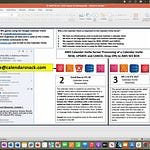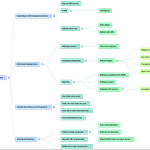1. The Challenge: The Disconnected World of Digital Event Marketing
In an era defined by digital interaction, event-based marketing remains a cornerstone of building meaningful customer engagement. The goal is always a seamless connection between a brand and its audience. However, the standard tools used today—a patchwork of “Add to Calendar” buttons and separate RSVP forms—often create the very friction and data silos they are meant to overcome, undermining the engagement they seek to build.
This conventional approach creates a frustrating journey for attendees, where a simple invitation becomes a multi-step ordeal of platform-specific buttons, redirects to separate landing pages, and manual form fills. This high-friction experience is a direct cause of the system’s second critical failure: disconnected data collection. Because the RSVP mechanism is a “bolt-on” workaround, attendee intent is captured manually through web forms, completely severed from the calendar event itself. This creates a data reconciliation nightmare and provides no real-time insight.
For event organizers, this disjointed process results in a fragmented and inefficient workflow that directly undermines the reliability of their communications. Managing events requires logging into multiple vendor platforms to generate buttons, manage forms, and send update emails. When an event detail changes, the only recourse is to send a new email blast and hope users manually update their calendars. This often fails, resulting in inaccurate “ghost” events on user calendars, which can cause confusion and damage brand credibility. This broken process of one-time data drops and manual follow-ups demands a fundamentally better approach.
2. The Solution: A Direct Messaging Pipeline to the Customer’s Calendar
The Calendar Invite Server represents a paradigm shift in event communication. It is not an incremental improvement on the old model but a new architecture that transforms a one-time “data drop” into a persistent, two-way communication channel. This channel is established directly on the most valuable real estate in the digital world: the customer’s personal calendar.
At its core, the Calendar Invite Server enables an organization to operate its own calendar server, replicating the functionality of platforms like Google or Microsoft for event communications.
It leverages an organizer’s native calendar client—such as Google Calendar or Microsoft Outlook—to create, update, and manage events. These events are then distributed via a robust API, making the organizer’s familiar calendar the single source of truth and giving the organization complete control of its messaging pipeline.
This native approach delivers powerful strategic advantages that address the critical flaws of the “Add to Calendar” and “RSVP From Hell' methods.
Achieve seamless attendee interaction: An actual, native calendar invite is sent directly to the attendee, where a single “Yes, No, Maybe” click within their email or calendar client confirms their status and adds the event, dramatically reducing friction and boosting engagement rates.
Automate first-party data collection: Every Y/N/M response is an authenticated “calendar receipt” sent directly back to the server, providing a real-time “intent signal” for analytics and automated decision-making without the need for manual form fills.
Guarantee event updates & cancellations: When an organizer changes an event’s time, location, or details in their own calendar, the update is reliably and automatically pushed directly to the event on every attendee’s calendar, ensuring accuracy and maintaining trust.
Unify the organizer workflow: The entire event lifecycle—from sending initial invites to tracking RSVPs, pushing updates, and processing cancellations—is managed from a single, familiar calendar client, eliminating the need for complex, multi-vendor workflows.
Ensure universal reliability: The system’s reliability stems from its foundation on universal IETF protocols, ensuring consistent performance across all major clients, including Google, Microsoft, and Apple. Comprehensive international language support is achieved by using AWS SES RAW for standards-compliant invite assembly and delivery.
This unique combination of benefits is made possible by a powerful and elegant serverless architecture.
3. Core Architecture: How the Calendar Invite Server Works
The power of the Calendar Invite Server lies in its scalable, serverless AWS architecture. The system comprises four distinct, automated processors that work in concert to manage the entire event lifecycle, from creation to data collection.
Inbound Processor: Effortless Event Creation
Function: An organizer creates, updates, or cancels an event in their native calendar client (e.g., Google or Outlook) and sends it to a designated AWS SES email address. The Inbound Processor receives this email, disassembles the event data, assigns a unique event ID (UID), and stores the normalized data for distribution.
Business Value: This workflow allows organizers to use the familiar, powerful tools they have already mastered. It eliminates the need to learn new software or navigate complex third-party vendor platforms for event creation.
Outbound Processor: Scalable, Compliant Distribution
Function: Using the Calendar Invite Send Rest API, an application can call the stored event data by its UID. The Outbound Processor reassembles the calendar invite using AWS SES RAW, which ensures standards-compliant delivery, supports international languages, and includes a request for an RSVP response.
Business Value: This provides a robust, developer-friendly way to integrate dynamic event invitations into any email campaign, web page, or application workflow, enabling mass-scale distribution.
Update/Cancel Processor: Automated Lifecycle Management
Function: This processor automates the distribution of event changes. When an organizer updates an event in their client, the new invite is automatically sent to all attendees who had previously responded with ‘Yes’ or ‘Maybe’. Critically, if an event is canceled, the cancellation notice is distributed to all original recipients for that event UID, regardless of their RSVP status. An optional workflow switch can be enabled to require manual approval before updates are sent.
Business Value: This maintains the calendar as the definitive single source of truth. It guarantees that attendees always have the correct information, eliminating the brand damage caused by missed updates or confusing “ghost” events left on calendars.
Data Collection Processor: Capturing Real-Time Intent
Function: The system actively requests and receives calendar receipts—the “Yes, No, Maybe” responses—from each attendee’s calendar client. This data is sent back to the API gateway, processed, and stored in DynamoDB. If an attendee later changes their response (e.g., from “Maybe” to “Yes”), that change is also captured and updated, keeping the data current.
Business Value: This transforms the calendar from a static entry into a live, first-party data source, providing valuable insights. It captures a valuable “intent signal” that is far richer and more reliable than a simple web click, giving deep insights into audience engagement.
These powerful mechanics enable a wide array of real-world applications across marketing and operations.
4. Strategic Applications: From Marketing Campaigns to Enterprise Solutions
The Calendar Invite Server’s API-first design makes it exceptionally versatile. It can be deployed across a wide range of marketing, transactional, and custom-built applications, transforming static information into dynamic, engaging, and trackable events that live on a customer’s calendar.
Use Case 1: Interactive Web Pages
The API can be used to send calendar invites directly from any web page. This is ideal for auto-generated event landing pages where users enter their email addresses to receive a one-click calendar invitation, creating a seamless conversion point.
Use Case 2: Email Marketing Integration
API event codes can be generated and embedded directly into Call-to-Action (CTA) buttons within email marketing templates. This model is compatible with over 50 major email marketing vendors, enabling organizations to seamlessly integrate powerful, trackable calendar events into their existing campaigns.
Use Case 3: In-App Transactional Notifications
The REST API can be integrated directly into software applications to handle critical transactional notifications. Examples include sending calendar invites for invoice due dates, sending mass reminders to users who have already signed up for an event, or delivering machine-to-human maintenance notifications as actionable calendar entries.
Use Case 4: Powering Large-Scale Custom Event Sites
A comprehensive demonstration of the platform’s capabilities is the NFL schedule mini-site, which turns the entire 272-game season into a dynamic, interactive calendar experience. This use case highlights several key strategic outcomes:
Frictionless Fan Engagement: Fans can add a single game, multiple games, or an entire team’s schedule to their personal calendar with a single click, directly from the website.
Dynamic, Living Events: The calendar is the source of truth. When the NFL announces time changes or flex scheduling adjustments, the updates are automatically pushed to the event on every fan’s calendar, ensuring they always have the correct information.
First-Party Data Ownership: Every invite sent creates a trackable, first-party record tied to the recipient. The organizer can measure real intent by tracking RSVP status (Yes, No, Maybe) without relying on third-party gatekeepers or black-box platforms.
Enriched Event Context: Raw event data is programmatically enhanced with additional context to create a richer experience. This is accomplished by combining core event data with external sources like
teamData.jsonfor logos and links, and public sports APIs for real-time stats and post-game scores, transforming a simple calendar entry into a dynamic content object.
These applications are designed to serve a range of organizations with sophisticated communication needs.
5. Go-to-Market: Ideal Customer Profiles & Channels
The go-to-market strategy for the Calendar Invite Server is focused on organizations that require scalable, integrated, and data-rich communication solutions. Four primary customer profiles are ideally suited to leverage this technology.
Large Digital Marketing Agencies. These organizations manage extensive web and email campaigns for multiple brands. The server provides a powerful tool for A/B testing promotions within email campaigns and embedding dynamic, interactive event schedules directly onto client websites to drive engagement.
Software OEMs. This segment includes companies that want to integrate native calendar functionality directly into their platforms for both marketing and transactional sending. Examples range from marketing automation platforms like HubSpot and Mailchimp to enterprise systems like SAP, which can use the API to send invoice reminders as calendar events.
Single OEM IP Buyer This profile represents an entity seeking to acquire the entire technology stack to commercialize it independently. Such a buyer could package and resell the solution across various industry verticals, building a business around its powerful capabilities.
AWS Partners AWS partners are positioned to package the solution for the AWS Marketplace and offer it as a licensed product. This is a significant opportunity, given the large existing user base of AWS Simple Email Service (over 25 million users) and other AWS customers who need a robust, permission-based calendar sending solution.
The product is packaged and deployed to meet the security, control, and integration needs of these enterprise-level customers.
6. Product Packaging, Deployment, and Data Ownership
The Calendar Invite Server’s packaging and deployment model is designed to provide enterprise-grade control, security, and seamless integration with existing cloud infrastructure. The core philosophy is simple: “You own it, you run it.”
Product Packaging
The product is delivered in two distinct packages that work together to provide a complete solution:
Back-End: This is the core Calendar Invite Server, delivered as an AWS CloudFormation template. It includes the Inbound, Outbound, and Update/Cancel processors that form the event messaging pipeline.
Front-End: This is a Vue.js console application for the Organizer and Domain Owner. It provides the user interface for managing events and communicates with the back-end server via a set of 9 developer-accessible APIs.
Deployment Model
The server is deployed directly into the customer’s own AWS account using the provided CloudFormation templates and documentation. This cloud-native, serverless architecture leverages a suite of powerful AWS services, including AWS Simple Email Service (SES), Amazon Simple Queue Service (SQS), API Gateway, AWS Lambda, Amazon DynamoDB, and Amazon Simple Storage Service (S3).
Security and Data Ownership
Because the entire system runs within the customer’s private AWS account, it inherently adheres to AWS serverless security best practices. This deployment model provides the ultimate benefit: the customer retains 100% ownership and control of all event and RSVP data. There is no reliance on third-party platforms, eliminating data silos and ensuring complete privacy and security.
This model provides unparalleled control, turning a simple calendar invite into a secure, owned communication asset.
7. Conclusion: Own the Signal, Own the Customer Relationship
The Calendar Invite Server enables organizations to move beyond the limitations of unreliable, high-friction “Add to Calendar” buttons + “RSVP FORMS” bolted on.
It provides the architecture to establish a direct, dynamic, and data-rich communication channel with any audience, right on their personal calendar. By transforming the calendar into a live intent signal, you can capture invaluable first-party data, guarantee the accuracy of your communications, and build stronger, more trusted customer relationships. It’s time to own the signal.
To learn more and see the technology in action, visit calendarinvite.com and explore the live NFL demonstration at nfl2025.31events.com, courtesy of Arnie.
The Calendar Invite podcast, featuring the Kitchen Sink Doc, from October 4th, is available here.








